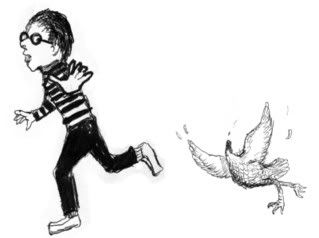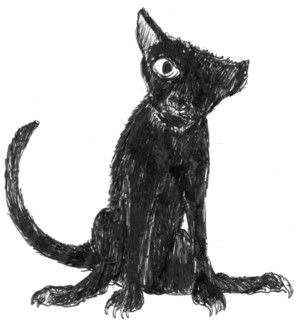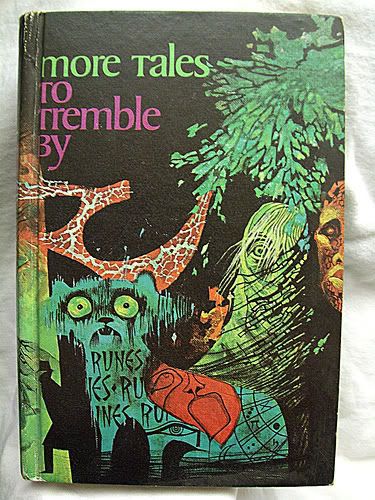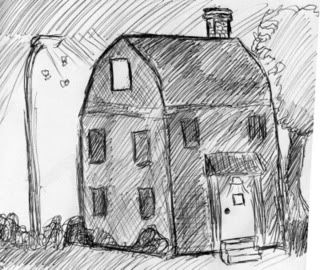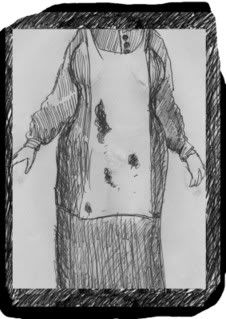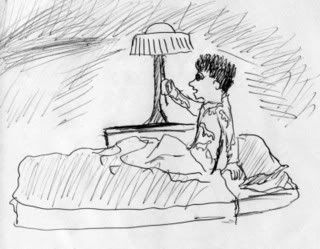While at Barnes and Noble this weekend, I picked up Neil Gaiman's new short novel for children The Graveyard Book and Kelly Link's new Young Adult collection Pretty Monsters. Despite the fact that most of my tattoos are from classic kid's books, I'm not a huge reader of contemporary children's or young adult literature (it may amaze some of you that I've never read Lemony Snickett or even J. K. Rowling), although my ex-girlfriend was, and my last published novella, "They are girls, green girls," had something of a Young Adult feel to it.
But Neil and Kelly are friends, albeit friends that I've not talked to in several years, and I think Kelly is one of the two best short story writers currently working in the English language (Neil agrees with me on that) and that Neil is hugely talented and deserves his huge success, even though I don't read him as much as I used to (I strongly disliked American Gods, which seems churlish of me to admit, as I'm one of the many people he thanks in the afterword).
Surprisingly, Kelly's book proved easier to find, as it was prominently displayed on the New Releases shelf at the front of the Young Readers section. Neil's I couldn't find at all, causing me to check the fantasy and the graphic novels sections, to see if it had been shelved where his older fans might notice it, but no, it wasn't there, and the bookfinder workstation claimed it was in "Juvenile Fiction." I finally asked a dottering old guy in a Barnes and Noble apron, but he couldn't find it either, and it took him asking a goth girl co-worker "have you seen the new book by that Neil Guy-man fella?" to turn it up. It actually had its own display rack, but one buried away at the very back corner of the Children's section.
At least I hadn't tried to find it at the local Borders, where I'm told by a former manager that their computer claims they don't have it yet, even though they really do, similarly buried in the back of the children's section where none of the staff knows to look. This seems odd, as the book has been getting a lot of press; a rave from Stephen Merritt of the Magnetic Fields in the New York Times Book Review, a rave at the Onion's AV Club, an NPR interview, etc.
I actually prefer Kelly as a writer to Neil (it's okay for me to say that, as he'd immediately agree with me), but I saved hers for last and am currently midway through his. It think it's the best thing he's written since Coraline (which I consider to be his most artistically succesful non-comics work). That it's essentially a riff on Kipling's The Jungle Book, with an orphaned boy being raised by ghosts (and a vampire who is essentially the Bagheera character) in a crumbling graveyard, only adds to the delight.
In the last couple of weeks I've seen Apaloosa and Tell No One in the theater. The first is a really fine old-school kickass Western that tweaks the traditional plots (there are several) in unusual ways, with exemplary work from Ed Harris and Viggo Mortensen as gunslingers who are practically a platonic couple and some really well-staged shoot-outs, refreshingly nasty and quick. Plus, Lance Henricksen! The second is a terrific French thriller based on an American novel by Harlan Coben, the plot of which it actually improves considerably. I can't recommend it strongly enough; the performances are all first-rate, there's a scary female henchman (an Asian male in the book), a splendid tense foot chase through Parisian traffic, and a nice sense we're seeing the "real" Paris rather than the usual movie one. Plus, despite the pace, it gives its characters room to breathe and they aren't just there to serve the plot. For instance, Kristin Scott-Thomas (who's been working in France for years) plays the wife (yes, wife) of the hero's sister, who is also his best friend. In an American thriller, you know she would end up either the killer or a victim, but I think it's one of the film's virtues that neither happens, and that her friendship with the protaganist is treated as something that just IS, rather than a red herring.
Now to watch the season finale of Mad Men, once it pops up On Demand.
But Neil and Kelly are friends, albeit friends that I've not talked to in several years, and I think Kelly is one of the two best short story writers currently working in the English language (Neil agrees with me on that) and that Neil is hugely talented and deserves his huge success, even though I don't read him as much as I used to (I strongly disliked American Gods, which seems churlish of me to admit, as I'm one of the many people he thanks in the afterword).
Surprisingly, Kelly's book proved easier to find, as it was prominently displayed on the New Releases shelf at the front of the Young Readers section. Neil's I couldn't find at all, causing me to check the fantasy and the graphic novels sections, to see if it had been shelved where his older fans might notice it, but no, it wasn't there, and the bookfinder workstation claimed it was in "Juvenile Fiction." I finally asked a dottering old guy in a Barnes and Noble apron, but he couldn't find it either, and it took him asking a goth girl co-worker "have you seen the new book by that Neil Guy-man fella?" to turn it up. It actually had its own display rack, but one buried away at the very back corner of the Children's section.
At least I hadn't tried to find it at the local Borders, where I'm told by a former manager that their computer claims they don't have it yet, even though they really do, similarly buried in the back of the children's section where none of the staff knows to look. This seems odd, as the book has been getting a lot of press; a rave from Stephen Merritt of the Magnetic Fields in the New York Times Book Review, a rave at the Onion's AV Club, an NPR interview, etc.
I actually prefer Kelly as a writer to Neil (it's okay for me to say that, as he'd immediately agree with me), but I saved hers for last and am currently midway through his. It think it's the best thing he's written since Coraline (which I consider to be his most artistically succesful non-comics work). That it's essentially a riff on Kipling's The Jungle Book, with an orphaned boy being raised by ghosts (and a vampire who is essentially the Bagheera character) in a crumbling graveyard, only adds to the delight.
In the last couple of weeks I've seen Apaloosa and Tell No One in the theater. The first is a really fine old-school kickass Western that tweaks the traditional plots (there are several) in unusual ways, with exemplary work from Ed Harris and Viggo Mortensen as gunslingers who are practically a platonic couple and some really well-staged shoot-outs, refreshingly nasty and quick. Plus, Lance Henricksen! The second is a terrific French thriller based on an American novel by Harlan Coben, the plot of which it actually improves considerably. I can't recommend it strongly enough; the performances are all first-rate, there's a scary female henchman (an Asian male in the book), a splendid tense foot chase through Parisian traffic, and a nice sense we're seeing the "real" Paris rather than the usual movie one. Plus, despite the pace, it gives its characters room to breathe and they aren't just there to serve the plot. For instance, Kristin Scott-Thomas (who's been working in France for years) plays the wife (yes, wife) of the hero's sister, who is also his best friend. In an American thriller, you know she would end up either the killer or a victim, but I think it's one of the film's virtues that neither happens, and that her friendship with the protaganist is treated as something that just IS, rather than a red herring.
Now to watch the season finale of Mad Men, once it pops up On Demand.


